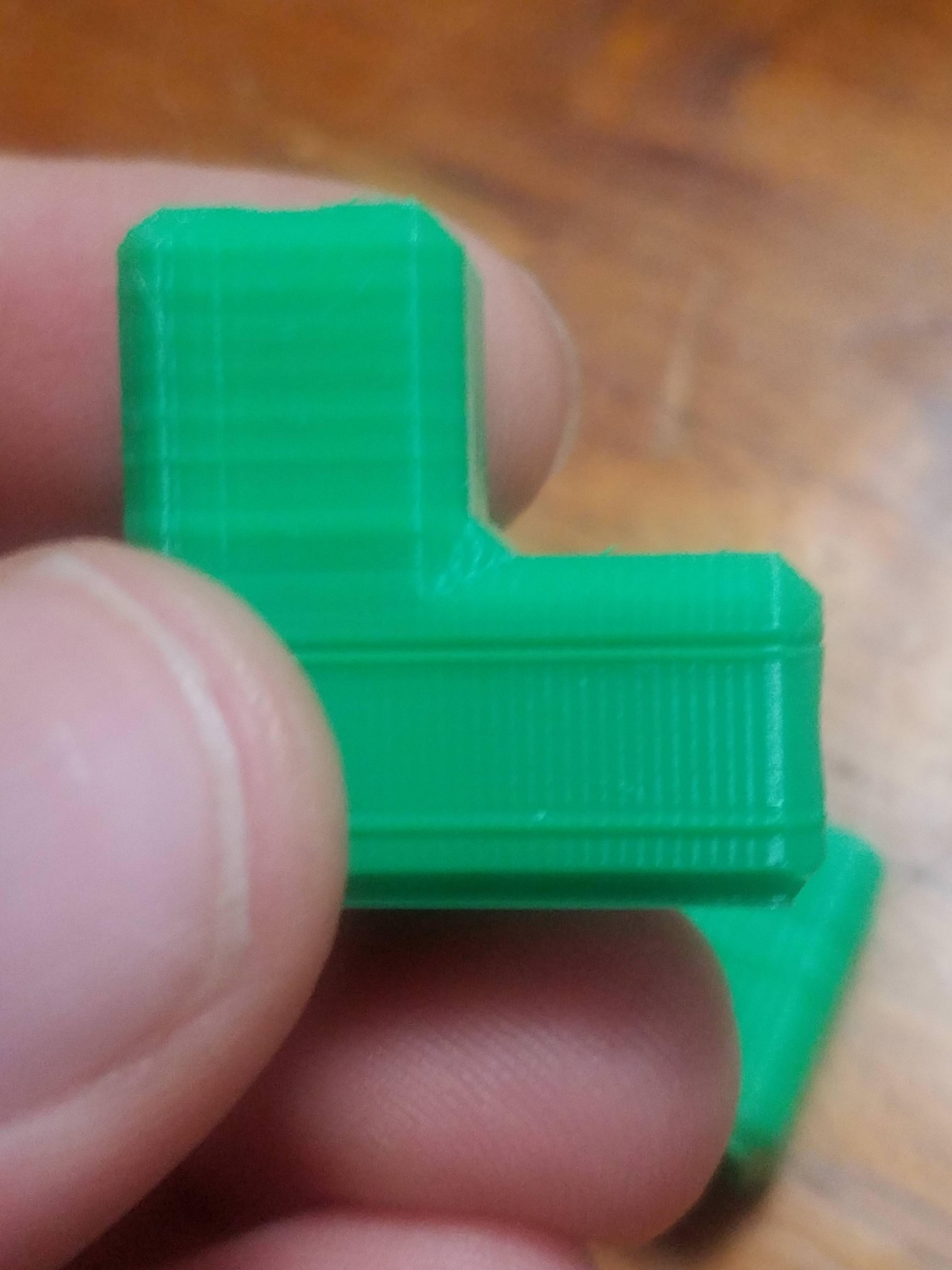
February 28, 2023
What is the reason of bad horizontal lines on 3d prints
Words
724
Time
2m 57s
Contributors
127
Words read
30.0k
Have an opinion? Send us proposed edits/additions and we may incorporate them into this article with credit.
Loose belt
Worn leadscrew nut
Non-smooth Z movement
Bang bang heating of the bed
Cleaning the Z-axis
All answers
Improper Calibration
Improperly Setup Printer
Heat Bed Controlled by Bang-Bang Control
Material Used
Jump to top
Research
 Source: "The Ultimate 3D Print Quality Troubleshooting G..." (from web, www.3dsourced.com)
Source: "The Ultimate 3D Print Quality Troubleshooting G..." (from web, www.3dsourced.com)
-
Platform not level
- Signs that your platform isn’t level: Either your nozzle is too near or too far (or both) at the same time along the X or Y-axis
- Explanation: When your platform isn’t properly leveled, i.e. the nozzle to bed distance varies in different locations across the bed, your nozzle might be too close in some areas and too far away in others.
- How to fix: On most printers, the print bed is leveled by adjusting 3 or 4 screws under the print bed. Leveling is actually not the correct term for what we’re doing, but that’s what everybody is calling it. What we’re doing is to make sure that the gap between the nozzle tip and the bed is the same all across the bed. Hence: the bed and nozzle are “level” with each other.
-
Platform is warped
- Signs your platform is warped: While printing the first layer, a warped bed will show effects of the nozzle being too near or too far.
- Explanation: Uneven or warped build platforms is the most common mechanical problem we’ve seen in today’s 3D printers and it can be observed in all price classes and all bed surfaces. Neither a milled aluminum plate, FR-4 board, or even a glass sheet is guaranteed to be 100% even.
- How to fix: Usually, you can work around warped build plates by printing a very thick first layer (but do not exceed maximum layer height = 75% nozzle size. i.e. 0.3mm for a 0.4mm nozzle). If all else fails, try printing with a raft. Also, with a warped build plate, leveling your bed in such a way that your nozzle to bed distance fits in a smaller area will allow you to work reliably with at least part of a warped build plate.
-
Clean your bed
- Signs the bed needs a clean: The bed isn’t spotless clean, if you see debris from a previous print, dust, gunk, spots, etc.
- Explanation: If your bed is dirty or has build-up, it can cause adhesion issues with your prints.
- How to fix: Clean your bed with isopropyl alcohol or acetone, depending on the bed surface. Make sure
 Source: "Ender 3 Z Axis issues" (from reddit, r/3Dprinting)
Source: "Ender 3 Z Axis issues" (from reddit, r/3Dprinting)
-
Installing a Z-Motor Spacer
- This is a 3D printed part which moves the motor out from the frame and prevents the lead screw from bending.
-
Loosening the Z motor bracket
- This prevents the motor from snagging on the mount.
-
Adjusting the board
- This will increase the speed and power of the motor, allowing for smoother movement.
 Source: "How can I fix layer shifting on every print?" (from reddit, r/3Dprinting)
Source: "How can I fix layer shifting on every print?" (from reddit, r/3Dprinting)
-
Loose belts
- Loose belts would cause the belt to jump across teeth on the pulley, which would show up mostly on fast accelerations like travel moves
-
Loose set screw on the pulley
- If the set screw is loose, then the pulley can slip on the shaft and cause layers to shift
-
Other mechanical problem
- Watch and listen to the print and see if there are any audio or visual cues like the extruder clicking causing this
-
Binding bearings
- With the printer off, move the head by hand back and forth repeatedly and see if it ever binds up
-
Underpowered stepper motors
- Increase the motor voltages on the drivers will increase current and torque, meaning the gantry will be able to cope with interferences better
-
Excessive warping
- Ensure proper layer adhesion
-
Faulty G-Code
- Double check your slicer is not the cause
-
Printer trying to go outside of the build area on part of the first layer
- The printer might be trying to go outside of the build area on part of the first layer, but it will get stuck and skip steps.
 Source: "New to 3d printing. I have horizontal lines app..." (from reddit, r/resinprinting)
Source: "New to 3d printing. I have horizontal lines app..." (from reddit, r/resinprinting)
-
Insufficient supports
- “As I understand it, this generally happens when you’re printing quite a big layer and it’s not got enough supports.”
- “I’d try adding a few more supports around the areas you’re getting layer lines and see if that helps.”
-
Layer shift
- “This looks like a layer shift. It could be related to your build plate being loose. Or an issue with supports as mentioned earlier.”
-
Z-rod cleaning
- “One thing you can also try is cleaning your z-rod. I had small layer shifts in about the same spot for a few prints of mine and cleaned it off, which fixed my horizontal line problem.”
-
Printing model on its back
- “Your layer lines appear to show that you were printing this model on its back. So the perpendicular layer lines are some weird kind of print anomaly.”
💭 Looking into
What are some good post-processing techniques for hiding horizontal lines in 3D prints?
💭 Looking into
What materials are more prone to highlighting horizontal lines in 3D prints?
💭 Looking into
What are the best practices for cleaning the Z-axis?
💭 Looking into
What are the disadvantages of using bang bang heating of the bed?
💭 Looking into
What causes non-smooth Z movement?
💭 Looking into
How can I tell if the leadscrew nut is worn?
💭 Looking into
What are the signs of a loose belt issue?
 Source: "9 Ways How to Fix Horizontal Lines/Banding in Y..." (from web, 3dprinterly.com)
Source: "9 Ways How to Fix Horizontal Lines/Banding in Y..." (from web, 3dprinterly.com)
-
Unsturdy printing surface
- Put your 3D printer on a stable surface
-
Printing speed too high
- Slow down your overall printing speed in 5-10mm/s increments
- Check your advanced printing speed settings for infill, walls, etc.
- Lower your jerk and acceleration settings so your 3D printer doesn’t vibrate due to fast initial movements and turns.
- A good 3D printing speed to go with is around 50mm/s
-
Abrupt temperature changes
- Ensure your temperature readings are keeping fairly steady, and doesn’t fluctuate more than 5°C.
- Use a brass nozzle for better thermal conductivity
- Implement an enclosure around your 3D printer to help stabilize temperatures
- Recalibrate and tune your PID controller if you see large fluctuations
-
Overextrusion
- Try decreasing your printing temperature in 5°C increments
- Check your nozzle isn’t worn out from long-term use or abrasive materials
- Look at your flow rate settings and lower if necessary
- Dial in your retraction settings so more filament isn’t oozing out
-
Incorrectly calibrated extruder
- Calibrate your 3D printer’s stepper motors by following a detailed tutorial
-
Mechanical issues or unstable printer parts
- Dampen vibration wherever possible, but I would advise against using floating feet because they can easily increase this issue.
- Make sure you properly tighten your belts
- Replace your belts with better quality ones
- Closely follow tutorials on how to put your 3D printer together so you don’t face future problems
- Tighten up screws around your 3D printer, especially with your hotend carriage and axis
- Keep your nozzle position accurate throughout your print
- Make sure your print bed is stable and well-connected to the rest of the 3D printer
- Check that your Z-axis threaded rod is placed correctly
- Ensure that the wheels on your 3D printer are properly tuned up and maintained
- Oil the relevant areas on your 3D printer with a light oil for smooth movements
-
Extruder skipping steps
- Use the correct layer heights for your stepper motor
- Calibrate your extruder motor
- Make
 Source: "Why are horizontal layer lines present on 3D pr..." (from web, helpcenter.phrozen3d.com)
Source: "Why are horizontal layer lines present on 3D pr..." (from web, helpcenter.phrozen3d.com)
None
 Source: "Horizontal lines in print. Whats causes this? -..." (from reddit, r/3Dprinting)
Source: "Horizontal lines in print. Whats causes this? -..." (from reddit, r/3Dprinting)
-
Loose belt issue
- Suggested to check the belts and ties
-
Worn leadscrew nut
- Suggested to check the threaded rods and its motors
-
Non-smooth Z movement
- Suggested to check the Z beam distance and make sure the hot end is not slipping
-
Bang bang heating of the bed
- Suggested to use PID control instead
-
Cleaning the Z-axis
- Suggested to clean the Z-axis
-
PID tuning
- Suggested to tune the PID
-
Replacing the Z-axes
- Suggested to replace the Z-axes including the motor, threaded rod and coupling
-
Printing bed screwed tight
- Suggested to make sure the printing bed is screwed tight
-
EStep calibration
- Suggested to calibrate the extruder
-
Gaps in x and y rails
- Suggested to check for gaps in the x and y rails
-
Cleaning up grooves all over the belt & gear pulley
- Suggested to clean up grooves all over the belt and gear pulley
-
Spoolholder
- Suggested to check if the spool is lifting when it’s hanging and if the extruder needs more power to get the filament from the spool
 Source: "How do I fix these ugly horizontal lines?" (from reddit, r/3Dprinting)
Source: "How do I fix these ugly horizontal lines?" (from reddit, r/3Dprinting)
-
Improper calibration
- Step calibration
- Flow rate calibration
- Improperly set up printer
- Heat bed controlled by bang-bang control
-
Material used
- Shiny black colors tend to show layer lines more
-
Improper slicing settings
- Volumetric flow in the gcode preview
-
Upgrading the printer
- Dual z screws
- 0.9° z-steppers
- 0.1mm nozzle
- Cleaning and lubing the z-rods
- Infill causing differences in layer print times
- Extruder, hobbed bolt/drive gear
-
Filament used
- Some colors and materials have the tendency to highlight every little inconsistency (white and shiny black)
- Layer height (0.5mm)
 Source: "Anybody know what causes the horizontal lines?" (from reddit, r/3Dprinting)
Source: "Anybody know what causes the horizontal lines?" (from reddit, r/3Dprinting)
-
Wobble on the z axis lead screw
- This is due to the slight wobble of the z axis lead screw and gets worse the taller the print is.
-
Layer lines
- These are due to the layer height used and can be hidden with sand and paint with filler or other post processing methods.
-
Z axis motor not sitting level
- This can be fixed by loosening screws and making sure the Z axis motor is sitting level.
💭 Looking into
What is the best way to avoid bad horizontal lines on 3D prints?